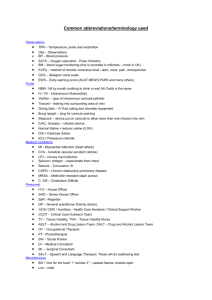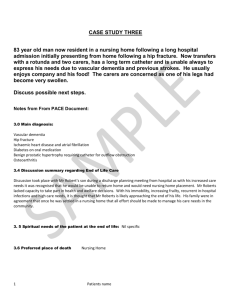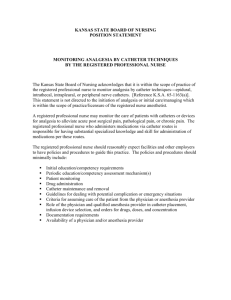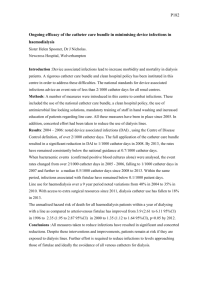Heparin for prolonging peripheral intravenous catheter use in
advertisement
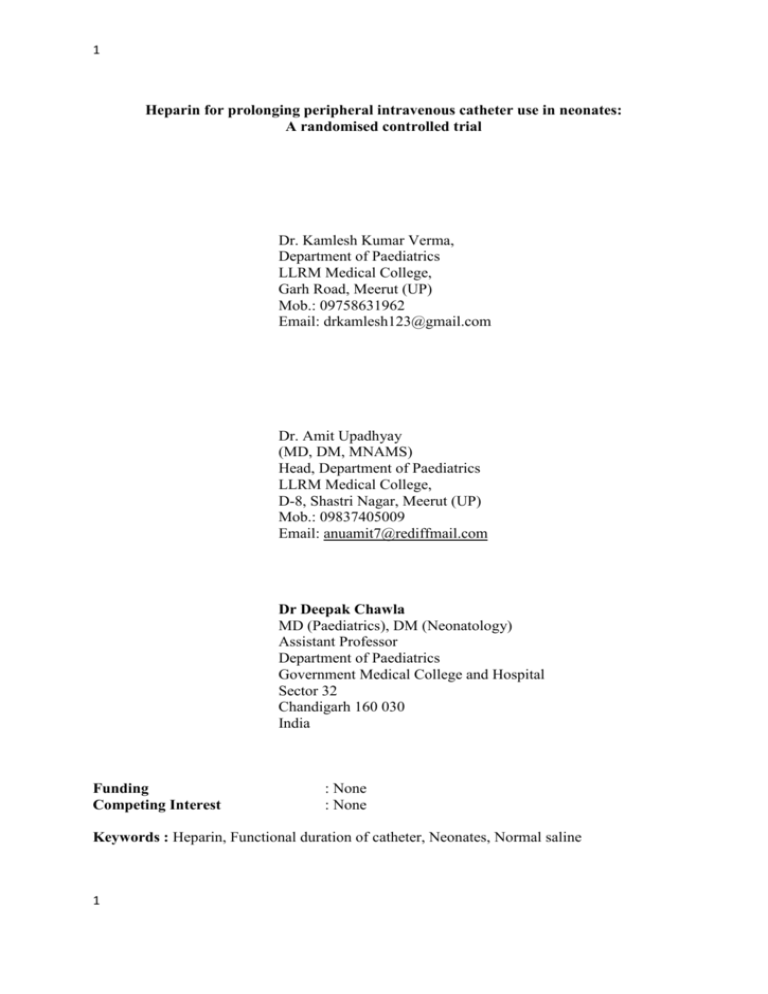
1 Heparin for prolonging peripheral intravenous catheter use in neonates: A randomised controlled trial Dr. Kamlesh Kumar Verma, Department of Paediatrics LLRM Medical College, Garh Road, Meerut (UP) Mob.: 09758631962 Email: drkamlesh123@gmail.com Dr. Amit Upadhyay (MD, DM, MNAMS) Head, Department of Paediatrics LLRM Medical College, D-8, Shastri Nagar, Meerut (UP) Mob.: 09837405009 Email: anuamit7@rediffmail.com Dr Deepak Chawla MD (Paediatrics), DM (Neonatology) Assistant Professor Department of Paediatrics Government Medical College and Hospital Sector 32 Chandigarh 160 030 India Funding Competing Interest : None : None Keywords : Heparin, Functional duration of catheter, Neonates, Normal saline 1 2 ABSTRACT Background: Mechanical and infectious complications shorten the effective duration of peripheral intravenous catheter. Heparin is used to prevent such complications and prolong the usability of peripheral intravenous catheter is inconclusive. Objective: To determine the efficacy of heparinised saline administered as intermittent flush via peripheral intravenous catheter on functional duration of the catheter in neonates. Method and material: Design: Randomised, double-blind placebo-controlled trial. Setting: Level II Neonatal intensive care unit of a teaching hospital. Participants: Term and Preterm neonates born at >32 weeks of gestation who required peripheral intravenous catheter for intermittent administration of antibiotics after admission with expected duration of hospital stay of >5 days. Intervention: Eligible neonates were randomized to receive 1 ml of either heparinised saline (10U/ml) (n=53) or normal saline (n=53) every 12 hours before and after antibiotics injection Primary outcome variable: Functional duration of 1st catheter Result: Both groups were comparable in birth weight, sex, postnatal age, site of catheterisation and nature of antibiotics given. Mean functional duration of 1st peripheral intravenous catheter was more in heparinised saline group ( hours; mean difference: 15.9; 95% CI: 8.5 to 23.3). Occlusion at the catheter site was commonest indication for catheter removal in both groups (77.3% vs. 71.7%). No difference was noted in complications related to heparin use. Conclusion: Heparinised saline flush increased the functional duration of peripheral intravenous catheter without any significant side effects. 2 3 INTRODUCTION Neonates with systemic sepsis, meningitis or arthritis need long-term intravenous antibiotic therapy, often without concomitant need of intravenous maintenance fluids. Peripheral intravenous catheters (PIVC) in such neonates have intermittent usage and tend to get blocked by blood clot at distal tip prompting frequent reinsertions. This exposes the vulnerable newborn infants to repeated painful and stressful experiences as well as the risk of infection due to skin breaches which might result in adverse effect on health and long-term neurodevelopmental outcome.1 Measures to prolong the functional duration of a PIVC may reduce the number of catheterisation attempts and save neonates from pain and stress as well as reduce the risk of infection.2 Heparin, an anticoagulant has been administered as an intermittent injection or continuous infusion to prevent thrombus formation and prolong catheter patency. A systematic review reported that heparin was not associated with prolongation in arterial or venous catheter patency among patients of different age groups. However, only one study in this review enrolled neonates. In addition, neonates are unique in their sensitivity to heparin and in propensity to develop intracranial hemorrhage4. We conducted this study to evaluate the efficacy and safety of heparinized saline flush in concentration of 10 unit/ml on functional duration of catheter among term and preterm neonates. MATERIAL AND METHODS This randomized controlled study was conducted at a teaching hospital of north India from October 2009 to September 2010. Study protocol was cleared by Institutional Ethical Committee and informed written consent was obtained from either parent before enrolment. Term and preterm neonates born at >32 weeks of gestation who required peripheral intravenous catheter for intermittent administration of antibiotics with expected duration of hospital stay >5 days were eligible for enrolment in the study. Neonates with intracranial hemorrhage, platelet count <150,000/mm3, coagulopathy or major congenital malformation were excluded. Allocation of group was done by block randomization. Randomization was done in block of 8 in two groups through computer generated random numbers which were then placed in 3 4 serially numbered opaque sealed envelopes. When a baby was eligible for enrolment a new PIVC was put after obtaining written consent from one of the parents. Enrolled neonates were randomized to receive immediately before and after each dose of antibiotic 1.0 ml of either heparinized saline containing 10 unit of heparin or normal saline. Study medication (heparinized saline or normal saline) was administered by a separately identified group of resident physicians and treating physicians, Nurses and parents were not aware of group allocation. Blinding was preserved by dispensing drugs and placebo in identical, indistinguishable containers. In neonates not requiring maintenance intravenous fluid therapy one PIVC was inserted and used for administering antibiotics only. In neonates on maintenance intravenous fluid therapy, a separate PIVC was used for administering antibiotics. The catheter to be given only intermittent intravenous antibiotics were included for study. Twenty-four gauge PIVC (NEOCAN Eastern Medikit Limited, India) were used for catheterisation in all neonates. Prior to the onset of the study, all healthcare personnel involved in insertion and fixation of catheter in the NICU were given instructions on the technique of insertion and fixation of PIVC. Insertion of PIVC was done by trained resident doctor on duty and fixation was done by trained nurse or another resident doctor. Study medication was administered immediately after catheter insertion and then immediately before and after each antibiotics injection at interval of 12 hours in both the groups. The catheter site was periodically monitored for development of sign of removal. The sign of removal was defined as presence of any one of the following: Occlusion: Defined as inability to infuse fluid. This was confirmed by resident doctor who attempted to push 1 ml of normal saline using a 5 ml syringe. Phlebites: defined as pain, swelling, erythema or indurations at the site of catheter with or without a palpable venous cord. Infiltration: infusate entering the subcutaneous tissue instead of the vein leading to swelling and difficulty in pushing antibiotics. Platelet count was obtained at time of enrolment and then every day starting fifth day of study enrolment till end of enrollment. Heparin induced thrombocytopenia (HIT) was defined using standard definition.5,6,7 Coagulation profile was done at the time of stopping study drug or if coagulation abnormality was suspected clinically. Study medication was stopped if neonates developed thrombocytopenia or coagulation defect or intracranial bleed. Intracranial hemorrhage was recognized by ultrasound which was obtained before enrolment, on clinical suspicion, on seventh day and at discharge from hospital. 4 5 Primary outcome variable was functional duration of first PIVC defined as the time between insertion and removal of the catheter. Secondary outcome variables were average catheter duration, was defined as numbers of hours of catheterization divided by total number of catheterizations. Other outcomes included complications associated with PIVC including occlusion, phlebitis or infiltration, abnormal coagulation profile, allergic reaction to study medication (fever, high blood pressure, heart rate >160/minute, respiratory distress, skin rashes consisting of red spot), heparin induced thrombocytopenia (HIT) defined as platelet count < 150000/mm3 after exclusion of other cause of thrombocytopenia. Sample size was calculated on the basis of a pilot study conducted in our hospital. We needed to enrol 50 subjects in each group to detect a 25% increase in functional duration of PIVC with 90% power with 95% confidence. To account for some unforeseen cases we decided to randomised 120 babies in two equal groups. All base line and outcome data were recorded prospectively on a pretested data form. The data were checked daily for completion, consistency and accuracy. Intention to treat analysis was performed by using software Stata version 11. Categorical variables were compared with chi square test and student t test was used for discrete and continuous variables. p value of <0.05 was considered significant. Observation and result Of the 130 eligible neonates 120 were randomized to two groups of 60 neonates each. All 60 babies were analysed on intension to treat analysis, seven babies in each group were could not completed the study protocols. In heparinised group 6 babies developed deceased platelet count and increased PT and APTT and their septic work up was positive and 1 expired during study period without blockage of catheter. In normal saline group 5 babies developed sepsis with decrease platelet count and increased PT and APTT and their septic work up was positive and two babies expired during study period without blockade of catheter according to defined criterion (Fig1). The groups were comparable with respect to postnatal age, sex, birth weight, mode of delivery, nature of IV antibiotics, site of catheterisation, person inserting catheter (Table 1). Primary outcome: There was a statistically significant increase in functional duration of 1st catheter in neonates in heparinized saline group as compared to normal saline group. Mean 5 6 functional duration of 1st catheter was more in heparinized saline group, mean (SD) of 79.2(18.3) hours as compare to 63 (20.0) hours in normal saline group (p<.005). Between two groups mean difference(95%CI) in functional duration of catheter was 15.9(8.5 to 23.3 hours) in favour of heparinized saline group (fig 2). Secondary outcome: (1) Average catheter duration was also more in heparinized saline group, mean (SD) of 77.99 (19.56) hours in compare to 58.73 (12.09) hours in normal saline group (p<0.005). Between two groups mean difference (95% CI) in average catheter duration was 19.26 (13.0 to 25.53 hours) in favour of heparinized saline group (fig 3). Occlusion at catheter site was commonest indication for catheter removal in both groups (77.3% vs 71.7%). There was no adverse effect on platelet count and coagulation profile, intra cranial bleed and allergic reaction in either group. DISCUSSION Our study demonstrated that use of heparinized saline flush (10 unit/ml) resulted in prolonged functional duration of 24-gauge catheter in neonates by almost 16 hours without affecting incidence of occlusion and phlebitis. There is limited evidence in neonatal age that use of heparin in peripheral intravenous catheter will prolong their life and utility in neonatal age. Mudge et al8 has earlier demonstrated the effectiveness of heparin flush solutions in maintaining the patency of 24-gauge peripheral intermittent infusion devices. It was however a non-randomized, sequential, but blinded study. The Kaplan Meier Survival demonstrate that the median duration of catheter flushed with heparin was 42 hours and with saline was 35.3 hours (p = 0.02). Kotter et al10 in 1996 reported that there was no statistically significant difference in average duration of patency between NS-flushed catheters and 10 unit/ml of HS-flushed catheters. Phlebitis, occlusion, infiltration, and leaking occurred with equal frequency for both solutions. Our study also demonstrated that with increasing gestational maturity functional duration of peripheral intravenous catheter also increases. This could be because at lower gestational age walls of veins are immature, thin with poor vascular tone Gupta et al11 studied variables affecting life span of a peripheral IV catheter in a NICU of a developing country. The median survival time of an IV catheter, as expressed by KaplanMeir survival analysis, was 40 hours (SE, 2.49; 95% CI, 35.12 to 44.88 hours). Birth weight, 6 7 gestation, application of splint, fluid and glucose infusion rate, site of catheterisation and administration of antibiotics, phenobarbitone, blood products, or calcium gluconate did not influence the median life span of IV catheter. In our study mean functional duration was more then as reported by Gupta et al.11 This probably because only IV antibiotics were give thorough peripheral IV cannlae (cefotaxime, ceftriaxone , pipercillin tazobactum) and no other irritant fluid was being administered. In our study 7 babies could not be analysed in each group. In heparinised group six babies developed clinical sepsis with feature of DIC (decreased platelate count and increased PT and APTT) before catheter blockage as defined criterion in our study and one baby expired before catheter blockage. In normal saline group five babies developed clinical sepsis and feature of DIC and two babies expired before completion of study. In conclusion it can be stated that administration of heparinised saline in concentration of 10 unit/ml increases the functional duration of peripheral intravenous catheter in neonates without any effect on platelate count and coagulation profile. Competing interest: none Ethics approval: Ethics committee approval was obtained from ethics committee, LLRM Medical College Meerut, India WHAT IS ALREADY KNOWNUse of heparin for increasing functional duration of arterial catheter is all ready documented, but its use for peripheral intravenous catheter especially in neonates is very debatable. WHAT THIS STUDY ADDSUse of heparinized flush increases the functional duration of peripheral intravenous catheter. No significant side effect could be related to use of heparin 7 8 REFERENCES 1. Johnston CC, Stevens BJ. Experience in a neonatal intensive care unit affects pain response. Paediatrics 1996; 98:925–30. 2. Batton DG, Maisels MJ, Appelbaum P. Use of peripheral intravenous catheters in premature infants: a no-splinted study. Paediatrics 1982; 70:487–9. 3. Randolph AG, Cook DJ, Gonzales CA, Andrew M. Benefit of heparin in peripheral venous and arterial catheters: systematic review and meta-analysis of randomised controlled trials. BMJ 1998;316: 969–75. 4. Lesko Lesko SM, Mitchell AA, Epstein MF, Louik C, Giacoia GP, Shapiro S. Heparin use as a risk factor for intraventricular hemorrhage in low-birth-weight infants. New England Journal of Medicine 1986;314: 1156–60. 5. Ahmed I, Majeed A, Powell R (September 2007). “Heparin induced thrombocytopenia: diagnosis and management update”. Postgrad Med J83 (983): 575-82. 6. Warkentin TE “Think of HIT”. Hematology Am Soc Hematol Educ Program 2006: 408-14. 7. Warkentin TE, Aird WC, Rand JH. “Platelet-endothelial interactions: sepsis, HIT, and antiphospholipid syndrome”. Hematology Am Soc Hematol Educ Program (2003): 497519. 8. Mudge B, Forcier D, Slattery MJ Pediatr Nurs. 1998;24(2):142-5, 149. 9. Shah P, Ng, Sinha A, Shah P. Heparin for prolonging peripheral intravenous catheter use in neonates. Cochrane Database Syst Rev. 2005;(4) :CD002774. 10. Kotter RW Neonatal Netw. 1996 Sep;15:43-7. 11. Gupta P, Rai R, Basu S, et al. Life span of peripheral intravenous catheter in a neonatal intensive care unit of a developing country. J Pediatrics 8 9 Table 1 Base line characteristics of neonates enrolled in two groups Base line variable Post natal age* (days) Birth weight (gms) ** Heparinised group (n=53) 5.74 2180 (1610-3315) Normal saline group(n=53) 4.6 2130 (1410-3215) 23(43.3%) 30(56.6%) 28(52.8%) 25(58.2%) 37(68.5%) 31(55.3%) 62(68.8%) 18(20.0%) 10(11.1%) 53(60.9%) 22(25.2%) 12(13.7%) 72(80%) 18(20%) 67(77.0%) 20(33.0%) 10(18.8%) 40(75.4%) 03(5.6%) 53(100%) 15(28.3%) 37( 69.8%) 1(1.8%) 53(100%) Mode of deliveries** Cesarian Others Sex Male Site of catheterisation** Extensor surface of hand Flexor surface of fore arm Others Canula insertor Junior resident 2 years Junior resident 3 years Antibiotics Cefotaxime Ceftrixone Piperacilline Amikacin Date express as *mean (SD), ** Median (range) Data express as value (n=%) 9 10 10 11 Fig. 1 Flow diagram of participant’s enrolment 11 12 Fig 2 : Kaplan Mayer survival estimates for comparison of functional duration of first catheter in two groups (Group 1= Normal saline , Group 2= Heparinized saline group ) 12 13 Fig 3: Box and Whishker plot for average duration of cathetere in the two groups (G –avg = Average cannula duration, group 1 = normal saline group, group 2 = heparinized saline group) 13


